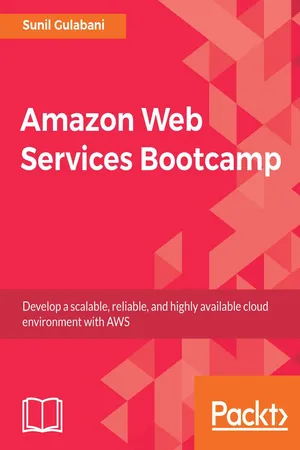
- 338 pages
- English
- ePUB (mobile friendly)
- Available on iOS & Android
Amazon Web Services Bootcamp
About This Book
This fast-paced guide will quickly enhance your skills to develop a highly scalable Cloud environmentAbout This Book• Efficiently build a highly scalable and reliable cloud environment for your applications with AWS• Leverage the various AWS components and services to build a secure, reliable, and robust environment to host your applications on• This quick-start guide will quickly enhance your skills to develop highly scalable servicesWho This Book Is ForThis book is for IT professionals and system administrators looking to design, deploy, and manage your applications and services on the AWS cloud platform. It's also ideal for developers looking to build highly scalable cloud-based services. A basic understanding of AWS would be beneficial.What You Will Learn• Find out about IAM to access AWS services securely• Explore EC2 (virtual server) and scale up/down your application based on heavy traffic• Learn about unlimited data storage service S3 and host a static website within minutes• Get to grips with Relational Databases and NoSQL databases under the AWS ecosystem• Understand the caching mechanism• Get to know about notifications service and monitor AWS services• Secure and troubleshoot your AWS architectureIn DetailAWS is at the forefront of Cloud Computing today. Businesses are adopting AWS Cloud because of its reliability, versatility, and flexible design. The main focus of this book is teaching you how to build and manage highly reliable and scalable applications and services on AWS. It will provide you with all the necessary skills to design, deploy, and manage your applications and services on the AWS cloud platform. We'll start by exploring Amazon S3, EC2, and so on to get you well-versed with core Amazon services. Moving on, we'll teach you how to design and deploy highly scalable and optimized workloads. You'll also discover easy-to-follow, hands-on steps, tips, and recommendations throughout the book and get to know essential security and troubleshooting concepts. By the end of the book, you'll be able to create a highly secure, fault tolerant, and scalable environment for your applications to run on.Style and approachThis book is all about fast and intensive learning. That means we don't waste time helping you get started. The new features provided by AWS resources are being covered with highly-effective examples to develop new things, demonstrating different ways to create and use the AWS resources efficiently.
Frequently asked questions
Information
Building Servers Using EC2
- EC2 instance types
- Amazon Machine Images (AMI)
- Key pairs
- Security groups
- EC2 instances
- Elastic Load Balancer
- Auto Scaling groups
- Elastic Block Storage
- On-demand: On-demand instances are useful where we need short-term instances. When you don't know whether you need an instance for a longer time, then you may go with on-demand instances. Amazon charges you based on hours for on-demand instances.
- Reserved instances: Reserved instances are used when we know we want our servers to be up and running for a longer period of time, say, more than 1 year. This helps us to reduce the cost by 75% when compared to on-demand instances. We need to purchase reserved instances based on instance types and pay the upfront fees.
- Spot instances: Spot instances help us to reduce the cost, as we need to bid for the instances. If Amazon has spare instances in its fleet, you may get them. These instances can be terminated within 2 minutes by Amazon by giving notification. These types of instances are useful when we want to perform small activities and we are not hampered if the instances are terminated in between activities.
- Dedicated hosts: Dedicated hosts are often used by AWS customers who want their EC2 instances to run on isolated physical hardware. Other AWS customer instances are not running on this dedicated host hardware.
EC2 instance types
- General purpose
- Compute optimized
- Memory optimized
- Accelerated computing
- Storage optimized
Amazon Machine Image...
Table of contents
- Title Page
- Copyright and Credits
- Packt Upsell
- Contributors
- Preface
- Getting Started with AWS
- Configuring IAM
- Building Servers Using EC2
- Storing Files on S3
- Managing RDS
- Implementing DynamoDB – NoSQL Database
- Implementing Caching Using ElastiCache
- Triggering Notifications
- All About CloudWatch
- Other Books You May Enjoy